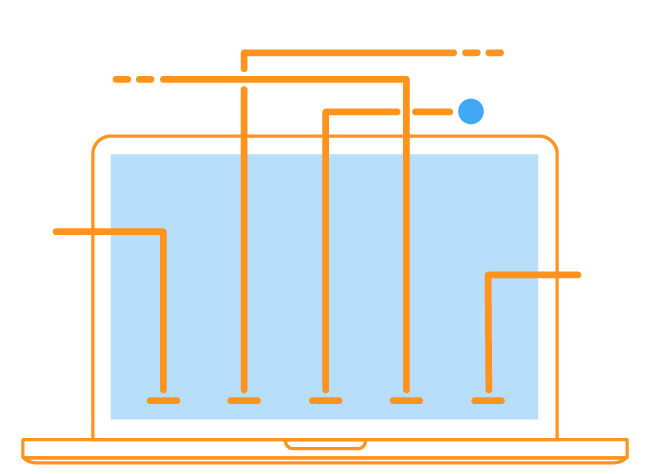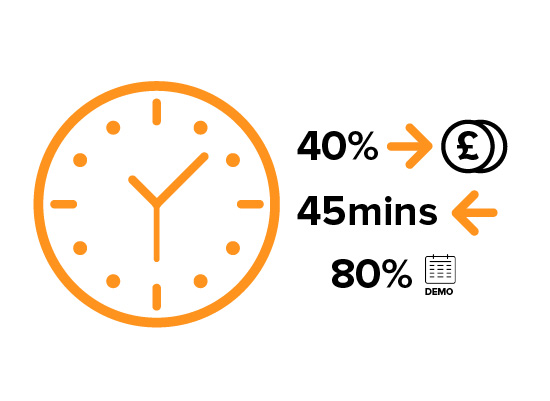The Quick, Quick, Slow of Marketing Automation
The Quick, Quick, Slow
of Marketing Automation

Sometimes you go online and you are just ready to buy there and then. Your washing machine is broken beyond repair and the kids’ football kits are piling up.
Other times, you are casting around for information to inform a buying decision further down the line. You’ve got a year left on the washing machine warranty and another little one taking up football in six months. You know you’ll be making a purchase soon…but not quite yet.
In the first instance, you want the purchase to be quick and easy. Sure, you want to understand what you’re buying, and to feel that it’s good value, but the efficiency of the transaction takes on great significance too. If a particular washing machine supplier is able to get in front of you and offer clear, comprehensive, efficient information, this may be enough to convince you to choose them there and then.
(Free delivery wouldn’t hurt, either).
In the latter instance, you’re definitely not looking for a hard sell – you’re possibly not looking for any direct engagement with the washing machine supplier at all. You’re gathering information, working out what matters to you, which suppliers look good value, or innovative, or otherwise impressive.
Timing is critical
The same principles apply in the B2B world. Here at CANDDi we’ve noticed that 40% of first-time visitors to our website make a purchase. We’ve also noticed that if we approach them within 45 minutes of their visit to our website, we have an 80% chance of booking in a demo.
But we have to be quick off the mark. If we leave them alone for 24 hours, the chances of a demo fall to just 25%.
Maybe they’ve forgotten some of the information they had at their fingertips when they were actually on our website, and consequently aren’t as engaged. Maybe they’ve spoken to a competitor in the time since.
On the face of it, we just need to be quick off the mark to sign up that 40% of prospects. Simple?

Try CANDDi today
Book a demo nowBeware of the alienation effect
But here’s the conundrum.
The remaining 60% of visitors to the CANDDi website, we’ve found, are generally between six and 12 months away from being ready to make a purchase. Sometimes they need their CANDDi deployment to fit with other technology projects they have planned, like a new CRM system or email automation platform. Sometimes they’re exploring their options while still under contract elsewhere. Sometimes they’re in the process of building a new website and know they want CANDDi to be part of it – but it’s not due to launch for six months.
These customers aren’t ready to buy, and nothing we can do will alter that.
Worse still – if we go in too aggressively, we run the risk of alienating them, leaving a poor (and inaccurate) impression of the business.
Imagine a company looking to change its marketing agency or legal advisors. When they first start looking at other suppliers, they are doing just that – looking around. Their current supplier has been with them a long time and is deeply embedded into their business practices. They cannot – and should not – chop and change at will.
If your organisation’s products or services are similarly ‘long-term’, or if your customers need to have a long transition period between browsing and buying, you’ll face the same challenge.
So let’s just ignore those prospects who are ‘just looking’?
The answer seems clear. We focus our attentions on being quick off the mark with the 40% of customers who are ready to buy today, and leave the rest to explore our website at their leisure.
But then it’s just as clear that this makes no sense. Ignore over half of our potential new business prospects just because they’re not ready to buy right now? Don’t forget, these are people who have actively arrived on our website. Whether through a direct Google search or a click on a link, they have proactively sought out CANDDi.
Until the rise of web intelligence and marketing automation products like CANDDi there was another problem, too. How would we identify the point at which those 60% stop being ‘potential customers of tomorrow’ and turn into ‘potential buyers of today’? For that matter, how would we tell the difference between the 40% and the 60% at all?

More than just IP addresses
Happily, we now have access to far more information about website browsers than just their IP address. We can find out how often individual users visit websites, what specifically they are looking at and how long they spend there.
CANDDi, for example, manages four key areas:
- It tracks all the traffic to a website, building a profile of visitors’ interests and engagement over time.
- It identifies those visitors, down to job titles and email addresses.
- It segments and scores visitors based on activity and behaviour.
- It alerts the business, ensuring that sales teams have the right information at the right time.
With highly intelligent marketing analytics and automation tools available, there’s no excuse for not managing browsers’ transition from the 60% to the 40% with ease and efficiency. There are three critical stages to consider.
1. Laying the foundations: informing and nurturing
This is the stage in which you’re keeping potential customers gently informed. You’re reminding them of who you are and what you have to offer them. It’s about being helpful and visible, navigating them through the ocean of choice to help them formulate a decision, and keeping your brand front of mind at all times. Even if you don’t expect them to shift from the 60% to the 40% any time soon, you want to know that when they do, they’ll remember you.
Key techniques during this stage include e-shots triggered by clicks on particular resources or certain numbers of activities, e.g. resource downloads or video views. Engaging content marketing via your website is also important, such as blogging, social media and the production of ebooks, videos and webinars. Targeted advertising can also work well.
At the back end of your website, you need to be analysing the interest levels around different pieces of content, and ensuring that the information those browsers want is consistently central and clear. What’s your most popular white paper, and why? Why have far fewer people watched video A than video B? Which questions keep getting emailed in, and which FAQs are the most read?
2. Spotting signs of change: monitoring and analysing
Worst-case scenario – you put all that effort into advising, informing and intriguing your potential customer, and then they take that knowledge away and use it to select a competitor. This is where you have to be both quick and smart – and this is where marketing automation comes into its own.
You need to be constantly on the lookout for any changes in behaviour that are the tell-tale signs that there is change in the air and the prospect may be moving from interest to desire or even action.
What do these changes look like? First, their visits to your site may be more frequent. They may be staying on the site for longer and may be downloading more content such as white papers or ebooks. They may start interacting with you on social media and sharing content. You may find other people from the target company are dropping by as the prospect wants others to check out your offering. They may start looking at areas of your site they had not visited before; maybe checking out members of your team or looking at case studies.
Clearly any attempt to manually analyze these changes would be impossible – you need an automation platform, like CANDDi, which is constantly monitoring and scoring visitors’ behaviour, ready to tell you when something has either radically altered, or a trend is becoming more marked.
3. Capitalizing on the tipping point: identifying and alerting
At this stage your sales team needs to deploy some sort of rapid but intelligent response. By using the data built up over time, you should know exactly how to engage next with your potential customer.
Perhaps it’s an e-shot to advise them of a special offer. Perhaps it’s a courtesy phone call. Perhaps you even need to set up a meeting. What’s so useful about the history you have built up on that individual over time is that you already know what content they are interested in – which topics and formats best engage them.
At this stage, things are hotting up and it’s time for quick decisive action – before someone else gets in there first. It’s vital that your sales team can access this history cleanly and quickly – and hopefully make the most of that 45 minute target.
Intelligent automation
Unless you are solely in the business of selling washing machines to distraught football parents on muddy match days, the chances are that much of your new business pipeline will be a combination of people ready to buy now, in a few months or even a couple of years.
Intelligence tools like CANDDi are essential in measuring the stage each and every prospect is at in their buying journey, making sure you don’t miss out on short term gains while maximising those prospects that are in the market but not quite ready to buy.

